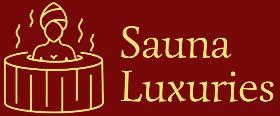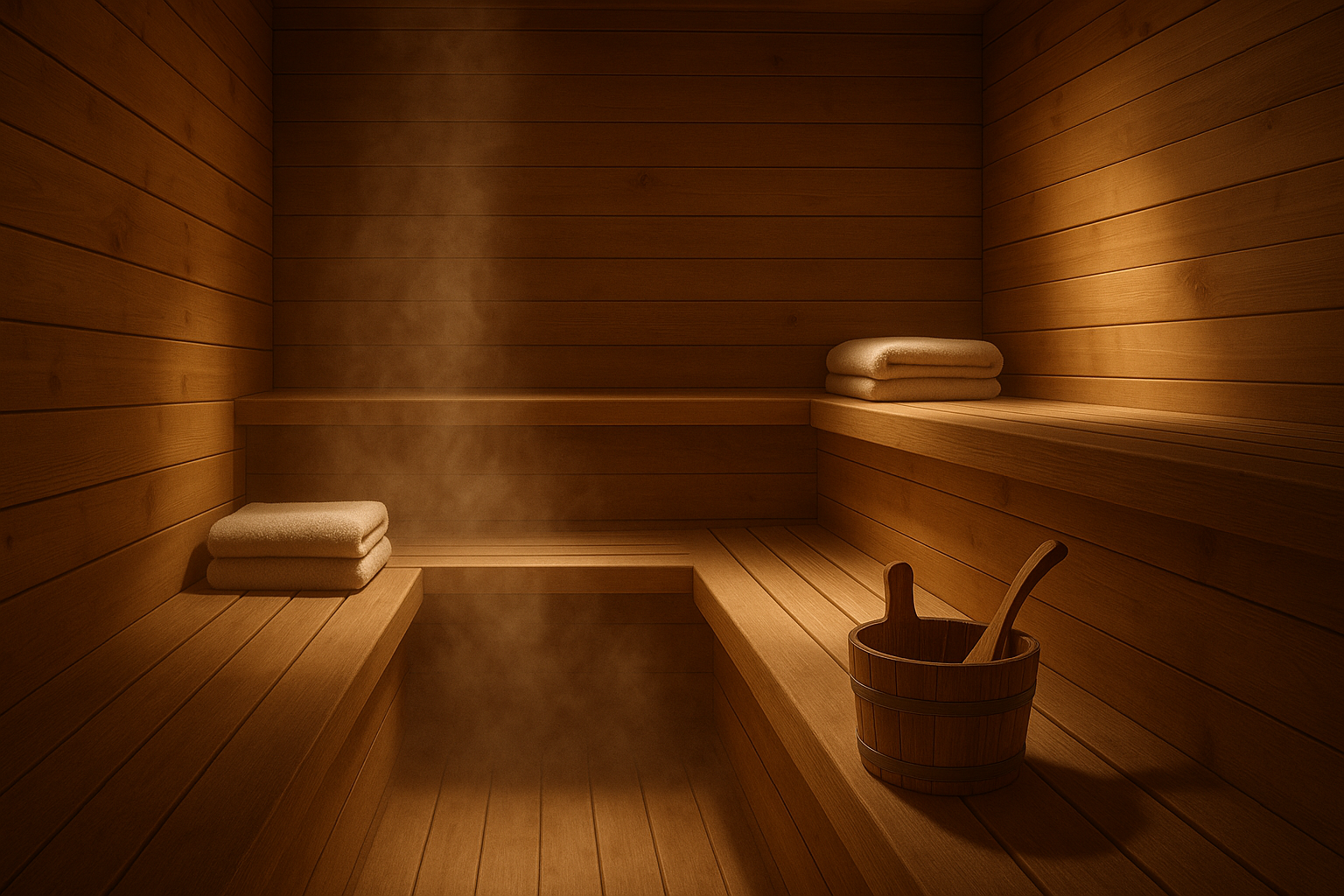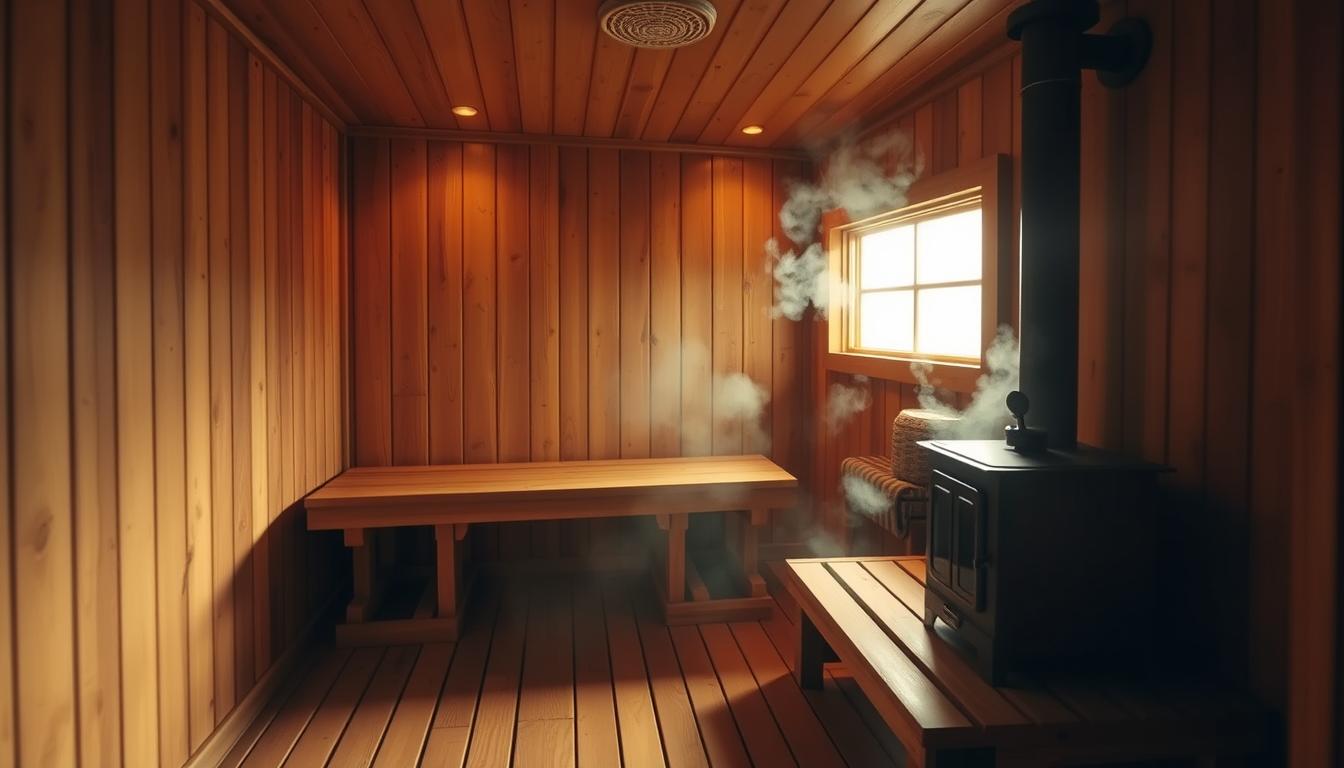
Explore the Proven Infrared Sauna Benefits for Wellness
Light-based heaters in an infrared sauna warm the body directly rather than heating the air like traditional steam or flame units. This method lets sessions run at lower temperatures—often between about 110–135°F—so many people find them more comfortable while still getting meaningful wellness effects.
Reported outcomes include improved cardiovascular markers, lower blood pressure, faster muscle recovery, reduced chronic pain, and better sleep. Routine use may also support circulation and help with stress relief through calm, sweat-centered sessions.

The article that follows lays out practical setup tips: where to start on temperature, session length limits, hydration and cool-down steps, and post-session rinse and recovery. It also covers safety, early signs of overheating, and who should consult a clinician before trying this form of therapy.
Key Takeaways
- Lower heat, direct warming: light-based units heat the body, not just the air.
- Evidence links regular sessions to improved heart markers and circulation.
- Follow simple safety steps: start low, hydrate, limit time, and rinse after.
- Users report less muscle soreness, pain relief, and calmer sleep patterns.
- Not appropriate for everyone—pregnancy, acute illness, or certain conditions need clinician input.
- Compare models and routines to match comfort, access, and goals.
Understanding Infrared Saunas vs. Traditional Saunas
Direct radiant panels warm the body itself, while a traditional sauna raises the air temperature in the room. This difference changes how a session feels, how quickly you sweat, and how long you want to stay.
The typical temperature range for these radiant units sits about 110–140°F, compared with 150–195°F for a traditional sauna. Because the heat targets tissues directly, many report similar sweat and circulatory responses at a lower ambient temperature.
Lower room heat also shortens preheat time and often eases breathing for people sensitive to hot air. That can make sauna use more comfortable for longer sessions without upping the perceived burden on the lungs.
"Direct warming can feel gentler even as core temperature rises, which explains why some users prefer this style of therapy."
https://www.youtube.com/watch?v=dFPfkHkOEEQ
- How they differ: panels/lights heat the body; traditional rooms heat the air.
- Typical temps: 110–140°F vs. 150–195°F.
- Practical impact: shorter preheat, gentler breathing load, and variable session length based on comfort.
Infrared Sauna Benefits Backed by Research and Real-World Use
Research and real-world reports point to consistent use producing exercise-like changes in blood flow and heart function. Repeated sessions widen blood vessels, raise heart rate modestly, and boost circulation. These physiological shifts resemble moderate exercise and can support improved blood pressure control over time.
Enhanced circulation also helps with muscle recovery. Many athletes and active adults notice less soreness and quicker recovery after workouts when they add routine sessions to their plan.
Clinical data and long-term reports link regular therapy to reduced chronic pain and better daily function. Users commonly report lower stress and improved sleep, which supports overall health.

Other observations include clearer skin after sweating and fewer common colds with ongoing use. Still, dedicated research on some claims is emerging, and some ideas—like broad detox effects—need more rigorous study.
"While promising findings exist, balance expectations and track results to see how regular sauna use fits your recovery and wellness plan."
- Cardiovascular effects: vasodilation, higher heart rate, better blood flow.
- Recovery and pain: improved muscle recovery and reduced chronic discomfort in some studies.
- Skin and immunity: clearer pores, lower inflammation signals, and possible immune support.
How to Use an Infrared Sauna Safely for Maximum Results
A cautious start—low heat and short sessions—helps build tolerance without unnecessary strain on the body. Begin with a mild temperature, pay attention to minutes, and increase slowly over several visits.
Start low and slow
Beginners can set an infrared sauna near 110°F and keep the first visits to about 5–10 minutes. Add time in small steps as comfort improves.
Session timing and weekly plan
Even experienced users should limit any sauna session to under 30 minutes. Aim for three to four sessions per week to support steady adaptation.

Hydration essentials
Hydrate before and bring water into the cabin. Consider electrolytes if you sweat heavily or go in after exercise. Avoid alcohol around sessions.
Post‑session routine
Cool down gradually, rinse off sweat, and rehydrate. Gentle stretching or breathwork can aid recovery and help muscle relaxation after therapy.
- Listen to your body: stop if dizzy or unwell.
- Progress slowly: increase temperature and time over weeks, not days.
Safety, Side Effects, and Who Should Avoid Infrared Saunas
Heat exposure carries clear risks when used without care; recognizing early warning signs protects users.
Stop immediately if you feel lightheaded, nauseated, or suddenly weak. Exit to cool air and drink water. These are early signs of overheating dehydration and require prompt action.
Overheating and dehydration: signs, prevention, and when to stop
Know common warning signs: dizziness, nausea, blurred vision, or sudden fatigue. If any occur, end the session and rehydrate slowly.
- Prevention: hydrate before, sip water during, and cool down afterward.
- Limits: keep sessions moderate and increase time gradually.
- Emergency signs: severe headache, confusion, fever ≥104°F, or a racing heart—seek care.

Special considerations
Certain groups should avoid hot cabins. Pregnancy, trying to conceive, acute illness, and multiple sclerosis carry added risk.
High core heat can harm fetal development and may affect sperm. People with MS often tolerate heat poorly and should get medical advice.
Medications, blood pressure, and clinician guidance
Some drugs change how the body handles heat and blood flow. Those with low or unstable blood pressure or cardiovascular disease should consult a clinician before you use infrared devices.
"Make sure to individualize frequency and duration based on your health status rather than following a one‑size‑fits‑all protocol."
Practical checklist: monitor symptoms, carry water, pause when unwell, and ask a clinician about medications or chronic disease. These steps reduce risk and help safe, effective use.
How Often to Use Infrared Saunas and When to Expect Benefits
A practical schedule balances short, regular sessions with careful attention to hydration and rest.
Recommended frequency from many facilities is three sessions per week as a starting point. Gradually build toward three to four sessions weekly. Keep most visits under 30 minutes. Beginners should start at about 5–10 minutes and add time slowly as tolerance improves.

What studies and facilities suggest
Research and clinical practice often report cardiovascular and circulation changes within the first few visits. Many people notice warmer, better blood flow right away.
Steadier gains—like improved muscle recovery and reduced chronic pain—usually show after several consistent weeks of use. Skin clarity and sleep commonly require repeated sessions over time to become noticeable.
Practical tips and timeline
- Start small: 5–10 minutes for novices, then increase toward 15–30 minutes as tolerated.
- Weekly plan: aim for three to four sessions per week to support adaptation.
- Adjust for load: scale back when ill, overly tired, or after hard training.
- Track outcomes: monitor sleep, pain, resting heart rate, and energy to personalize timing and duration.
"If you choose to use infrared sauna more frequently, keep sessions shorter and cooler to respect your body's heat tolerance."
Make sure to hydrate, cool down, and consult a clinician if you have cardiovascular issues or take heat‑sensitive medications. Sauna use should complement, not replace, other recovery practices.
Infrared Sauna Benefits vs. Traditional Sauna: Key Differences
Energy delivery differs: one style warms the body directly, while the other heats the surrounding air that then transfers warmth.
Direct‑panel models typically operate at a lower temperature range, often near 110–140°F, so many users find sessions feel gentler. Traditional rooms reach higher temperatures (150–195°F) and produce a more intense dry‑heat experience.
Both approaches can support relaxation, improved circulation, and favorable cardiovascular effects.
Which is better depends on personal tolerance, routine, and access. People who dislike hot air or want longer, comfortable stays may prefer infrared saunas. Those who enjoy ritual, higher heat, or steam-based contrast may choose a traditional sauna.
"The right choice is the one you’ll use consistently and safely within your lifestyle."
- Practical perks: direct models often warm up faster and fit at-home setups.
- Classic appeal: traditional rooms deliver a familiar, high‑heat ritual some users favor.
- Evidence note: broad research supports sauna therapy overall; device-specific data is still evolving.
Conclusion
Choosing a direct-warming model often means you can enjoy similar restorative results without extreme ambient heat. This makes regular sessions easier to fit into a routine and may improve adherence.
Clinical data support overall cardiovascular and recovery effects from heat therapy, and research on specific devices continues to grow. Many find that both infrared saunas and traditional saunas deliver useful circulatory and relaxation responses.
To get the most from any unit, start modestly, hydrate well, and limit time while you monitor how you feel. If you plan to use infrared sauna and have medical concerns, medications, or pregnancy plans, consult a clinician first.
Key takeaway: prioritize safety, consistency, and personal fit to make heat therapy a useful complement to your wellness routine.
FAQ
What are the proven benefits of near‑infrared heat therapy for wellness?
Heat therapy that uses near‑infrared wavelengths promotes cardiovascular activity similar to moderate exercise, supports muscle recovery, reduces some types of chronic pain, and can improve skin appearance by increasing circulation and promoting sweat-based pore cleansing.
How does lamp-based heat differ from a traditional steam room or high‑temperature cabin?
Lamp-based systems heat the body directly at lower air temperatures, delivering radiant energy that penetrates tissues. Traditional high‑heat cabins rely on hot air to raise core temperature and often operate at much higher ambient temperatures.
What typical temperature ranges should users expect with lamp systems versus traditional high‑heat rooms?
Lamp systems typically run between about 110–140°F, while traditional high‑heat rooms commonly reach 150–195°F. Lower air temps can make sessions more tolerable while still producing therapeutic warming effects.
Can regular sessions help blood pressure and heart health?
Repeated sessions mimic some cardiovascular responses seen with light to moderate exercise, such as improved circulation and transient blood pressure reductions. Individuals with heart disease should consult a clinician before starting a regimen.
How does this therapy aid muscle recovery and reduce post‑workout soreness?
The radiant heat increases local blood flow, which helps deliver oxygen and nutrients to damaged tissue and accelerates metabolic clearance, contributing to faster recovery and less delayed onset muscle soreness.
Is there evidence it helps chronic pain and joint discomfort?
Several studies and clinical reports show reduced pain scores for some chronic musculoskeletal conditions, likely from increased circulation, muscle relaxation, and modulation of pain signaling.
Will sessions improve sleep and reduce stress?
Many users report deeper relaxation and improved sleep patterns after sessions, attributed to lowered sympathetic activity and release of calming endorphins. Results vary among individuals.
How can this therapy affect skin health?
Increased circulation and sweating can help clear pores and reduce surface inflammation, often resulting in a smoother, clearer complexion over time when combined with good skincare.
Does regular use support immune function or reduce oxidative stress?
Short‑term rises in core temperature and heat‑shock protein activity may prime immune signaling and cellular stress responses. While promising, more research is needed to define clinical impacts on infection rates and long‑term oxidative stress.
How should a newcomer start to use lamp‑based heat safely?
Begin with lower temperatures and short sessions (for example, 10–15 minutes) and build tolerance gradually. Monitor how the body responds and add minutes across several weeks rather than starting at long durations.
What is an ideal session length and weekly frequency for results?
Many facilities and studies use sessions of 20–30 minutes, two to five times per week. Individual needs depend on goals, fitness level, and medical status; consult a provider for personalized guidance.
What hydration steps should users take to avoid dehydration?
Drink water before, during (if needed), and after sessions. Replace electrolytes for longer or frequent sessions. Avoid alcohol and heavy meals immediately before treatment to reduce dehydration risk.
What should be done after a session for best recovery?
Cool down gradually, rinse off sweat, rehydrate, and allow time for rest. Gentle stretching or light movement can aid circulation and recovery.
What are signs of overheating or heat‑related distress and when should a session stop?
Stop if dizziness, nausea, excessive weakness, rapid heartbeat, headache, or confusion occur. Move to a cooler area, hydrate, and seek medical attention if symptoms persist.
Who should avoid lamp‑based heat therapy or consult a clinician first?
Pregnant people, those trying to conceive, individuals with multiple sclerosis experiencing heat sensitivity, people with acute illness or unstable cardiovascular conditions, and anyone on medications affecting blood pressure or thermoregulation should consult their healthcare provider before use.
How do certain medications interact with heat treatments?
Drugs that lower blood pressure, alter heart rate, impair sweating, or affect fluid balance can increase risk of adverse effects. Review medications with a clinician to determine safety and any necessary adjustments.
When can users expect to notice improvements in sleep, pain, skin, and circulation?
Some people report immediate relaxation and transient pain relief after one session. Measurable changes in sleep, skin clarity, or chronic pain often take several sessions to a few weeks. Consistent use typically yields clearer timelines.
How often should someone use lamp-based heat to maintain benefits?
Maintenance often involves two to three sessions per week after an initial trial period. Frequency should match individual goals, tolerance, and medical advice.
What are the main differences between lamp‑based radiant heat therapy and traditional high‑temperature treatments?
Key differences include lower ambient temperatures with direct tissue penetration in lamp systems, potentially greater comfort for longer sessions, and distinct physiological responses compared with very high‑heat, steam‑based environments.







Leave a comment
This site is protected by hCaptcha and the hCaptcha Privacy Policy and Terms of Service apply.